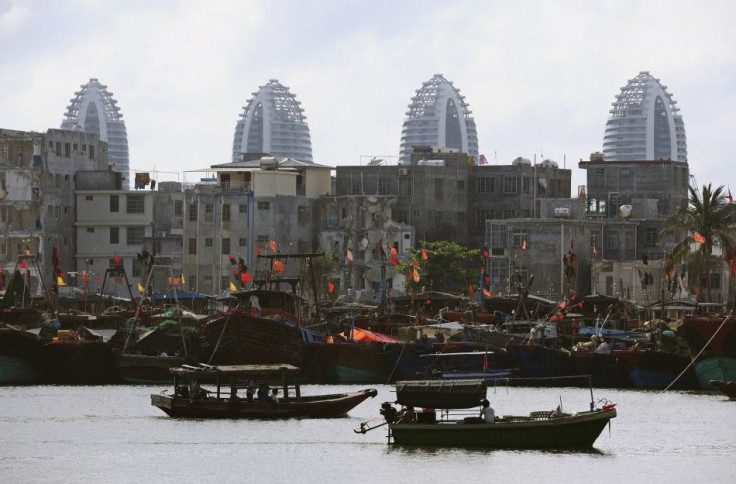High-End Hainan Island Tourism Projects Highlight China?s Wealth Gap

(Reuters) - A central government plan to create a high end tourist industry on the tropical Hainan island has delivered a much-anticipated surge in economic growth, but it has also widened the wealth gap between rich and poor that Beijing was trying to close.
Money has poured into prime seafront property to build five-star hotels, lush golf courses and marinas for private yachts, generating an investment-led boom that has seen the island's economy grow an average 35 percent faster than the rest of the country in the three years since the government campaign began.
But, for the 8.6 million population, the outcome has been inflation and yawning income disparity as family farms that once generated earnings of about 20,000 yuan ($3,174) a year are sold off for luxury homes that cost 150,000 yuan per square meter.
It is more like a hometown of rich outlanders, instead of ours, though we were born here and lived on this land for generations, said 26-year-old Zhang Xia, leaning against the door of a small, scruffy, sparsely-stocked grocery store, the only source of income for his family.
Zhang's parents used to grow mangoes on farmland, from where the family was relocated to clear land for construction of a tourist resort.
We were moved to a place far from the sea and there is no more land for planting. What can we make a living on? said Zhang, who now lives in the outskirts of Sanya, Hainan's second-biggest city.
This is a problem China has nationally - how to promote growth and investment that spreads wealth to local residents, not the already rich, or returns it to local government coffers.
A widening wealth gap is a critical risk for China's Communist government which stakes its claim to single party power on the promise of social stability and steady economic growth. Fail in that and the government risks triggering unrest.
Official data show that annual personal disposable income in Sanya averaged at 20,472 yuan in 2011, up 9.4 percent from a year earlier, but well below the city's economic growth and fiscal revenue, at 14.2 percent and 18.5 percent respectively.
Chinese Premier Wen Jiabao told the annual meeting of parliament in March that Beijing would pin down details of reforming the national income distribution system this year to quickly reverse the trend of a widening income disparity.
Meanwhile, the central government has also vowed to increase the share of individual income as a proportion of GDP to boost domestic consumption and shift towards a more balanced economy.
A widening income gap has become a main factor that constrains the expansion of domestic demand and could also undermine the sustainable growth of the economy, said Du Zhengzheng, an analyst at the China Development Bank Securities.
PRICED OUT
Average consumer prices in Sanya surged 5.4 percent in 2011 from a year earlier - well above the government's 4 percent target - with the annual food inflation speeding to as high as 13.7 percent, according to the city's statistics bureau.
The Sanya government is not oblivious to the problem.
We notice that the rising consumer prices are exerting a deeper and deeper influence on local residents. Some of them have to cut consumption on food to counter high inflation, it said in a report on its website.
In the first half of last year, with inflation then near three-year peaks, average personal consumption of beef sank 13.3 percent year on year, egg consumption dropped 29.7 percent while fish fell 5.4 percent, according to Sanya statistics bureau.
In 2011, the Sanya government gave each urban resident 42 yuan a month to subsidies food consumption.
The subsidy is only a one-off measure to tackle inflation. A therapy for a permanent cure is to largely increase the salaries of low-income groups and narrow the gap between rich and poor, said Qiao Yongyuan, an analyst at CEBM, a research and advisory firm in Shanghai.
The central government is also stepping up efforts to bridge the income gap.
Beijing has pledged to raise the annual average minimum wages by at least 13 percent in the five years to 2015 and it wants the local authorities to set the lowest wages at at least 40 percent of average local salaries.
Minimum wages in China range from 1,500 yuan per month in Shenzhen to 870 yuan in Chongqing.
Sanya is a potent example of how speculative funds have not only priced local people out of the real estate market but are fuelling home prices in some cities even as Beijing's property tightening policies help cool prices elsewhere.
Dong Yutang, a businessman from Harbin, one of the country's coldest cities in the northeastern Heilongjiang province, has just bought an 8 million yuan villa in Sanya, about 15 minutes drive from the seaside.
It is worth buying. I like spending winter here. And I don't quite worry about a price drop, given the prime location, he said.
Property investment in Sanya grew 34.6 percent last year, way above the national average rate of 27.9 percent.
Sanya's market outperforms many others across the country with the price of residential properties up nearly 50 percent over the past two years.
But the provincial government has started to think about cutting reliance on land sales and prepare for a shift to more balanced growth.
The development of one city should not overly rely on the property sector and we must attach particular attention to protecting the precious land resources of Hainan province to seek sustainable growth, Jiang Dingzhi, the governor of Hainan province, said late last year. ($1 = 6.3081 Chinese yuan)
(Editing by Ramya Venugopal)
© Copyright Thomson Reuters 2024. All rights reserved.






















